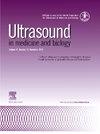Two-dimensional Speckle Tracking Echocardiography and Fetal Cardiac Performance During Fetoscopic Repair of Myelomeningocele
IF 2.4
3区 医学
Q2 ACOUSTICS
引用次数: 0
Abstract
Objective
No clinical standard exists for intraoperative fetal cardiac monitoring during maternal-fetal surgery for fetal myelomeningocele (fMMC). This pilot study explores the feasibility of using speckle tracking echocardiography (STE)-derived functional measurements to characterize cardiac performance throughout fetoscopic fMMC and compares these measures with other common intraoperative cardiac function parameters.
Methods
Continuous fetal echocardiography was performed during fetoscopic fMMC repair with fetal heart rate assessment every 2 minutes and a 4-chamber cine clip and mitral and tricuspid Doppler inflow patterns captured every 5 minutes. Offline postprocessing was used to measure functional data during fetal surgery including left ventricle (LV) global longitudinal strain (GLS), right ventricle (RV) GLS, LV ejection fraction (EF), and RV fractional area of change (FAC). Interrater agreement was determined for all measurements.
Results
Intraoperative fMMC echocardiograms were successfully obtained and analyzed for twenty patients. LV and RV GLS remained stable with a population average of -25.9±2.6% and -23.1±2.0% respectively during fMMC, and comparable to published normative ranges. Cardiac systolic and diastolic function was preserved at all surgical stages as demonstrated by LV EF, RV FAC, and spectral Doppler measurements. Interrater agreement for the spectral Doppler measurements was high, whereas STE agreement was low.
Conclusion
Fetal cardiac image acquisition for STE analysis was feasible during all stages of fetoscopic fMMC repair. Poor interrater agreement and offline post-processing limit the utility of STE for real-time clinical assessment, yet with experienced operators it could serve as a useful tool for scientific innovation to better understand modifiers of intraoperative fetal cardiac function.
二维斑点跟踪超声心动图与胎镜修复脊髓脊膜膨出时胎儿心脏表现。
目的:胎儿髓膜脊膜膨出(fMMC)母胎手术术中胎儿心脏监测尚无临床标准。本初步研究探讨了使用斑点跟踪超声心动图(STE)衍生的功能测量在胎儿镜fMMC过程中表征心脏功能的可行性,并将这些测量与其他常见的术中心功能参数进行比较。方法:在胎儿镜fMMC修复过程中,连续进行胎儿超声心动图检查,每2分钟评估一次胎儿心率,每5分钟记录一次四室电影夹和二尖瓣和三尖瓣多普勒血流模式。采用离线后处理技术测量胎儿手术过程中的功能数据,包括左心室(LV)整体纵向应变(GLS)、右心室(RV) GLS、左室射血分数(EF)和左室分数变化面积(FAC)。确定了所有测量结果之间的一致性。结果:成功获得20例患者术中fMMC超声心动图并进行分析。在fMMC期间,左室和右室GLS保持稳定,人群平均GLS分别为-25.9±2.6%和-23.1±2.0%,与公布的标准范围相当。通过左室EF、右室FAC和频谱多普勒测量,心脏收缩和舒张功能在所有手术阶段均得以保留。光谱多普勒测量的间一致性较高,而STE一致性较低。结论:胎儿心脏图像采集用于STE分析在胎儿镜fMMC修复的所有阶段都是可行的。较差的解释器一致性和离线后处理限制了STE在实时临床评估中的应用,但有经验的操作员,它可以作为科学创新的有用工具,更好地了解术中胎儿心功能的修饰因素。
本文章由计算机程序翻译,如有差异,请以英文原文为准。
求助全文
约1分钟内获得全文
求助全文
来源期刊
CiteScore
6.20
自引率
6.90%
发文量
325
审稿时长
70 days
期刊介绍:
Ultrasound in Medicine and Biology is the official journal of the World Federation for Ultrasound in Medicine and Biology. The journal publishes original contributions that demonstrate a novel application of an existing ultrasound technology in clinical diagnostic, interventional and therapeutic applications, new and improved clinical techniques, the physics, engineering and technology of ultrasound in medicine and biology, and the interactions between ultrasound and biological systems, including bioeffects. Papers that simply utilize standard diagnostic ultrasound as a measuring tool will be considered out of scope. Extended critical reviews of subjects of contemporary interest in the field are also published, in addition to occasional editorial articles, clinical and technical notes, book reviews, letters to the editor and a calendar of forthcoming meetings. It is the aim of the journal fully to meet the information and publication requirements of the clinicians, scientists, engineers and other professionals who constitute the biomedical ultrasonic community.

 求助内容:
求助内容: 应助结果提醒方式:
应助结果提醒方式:


